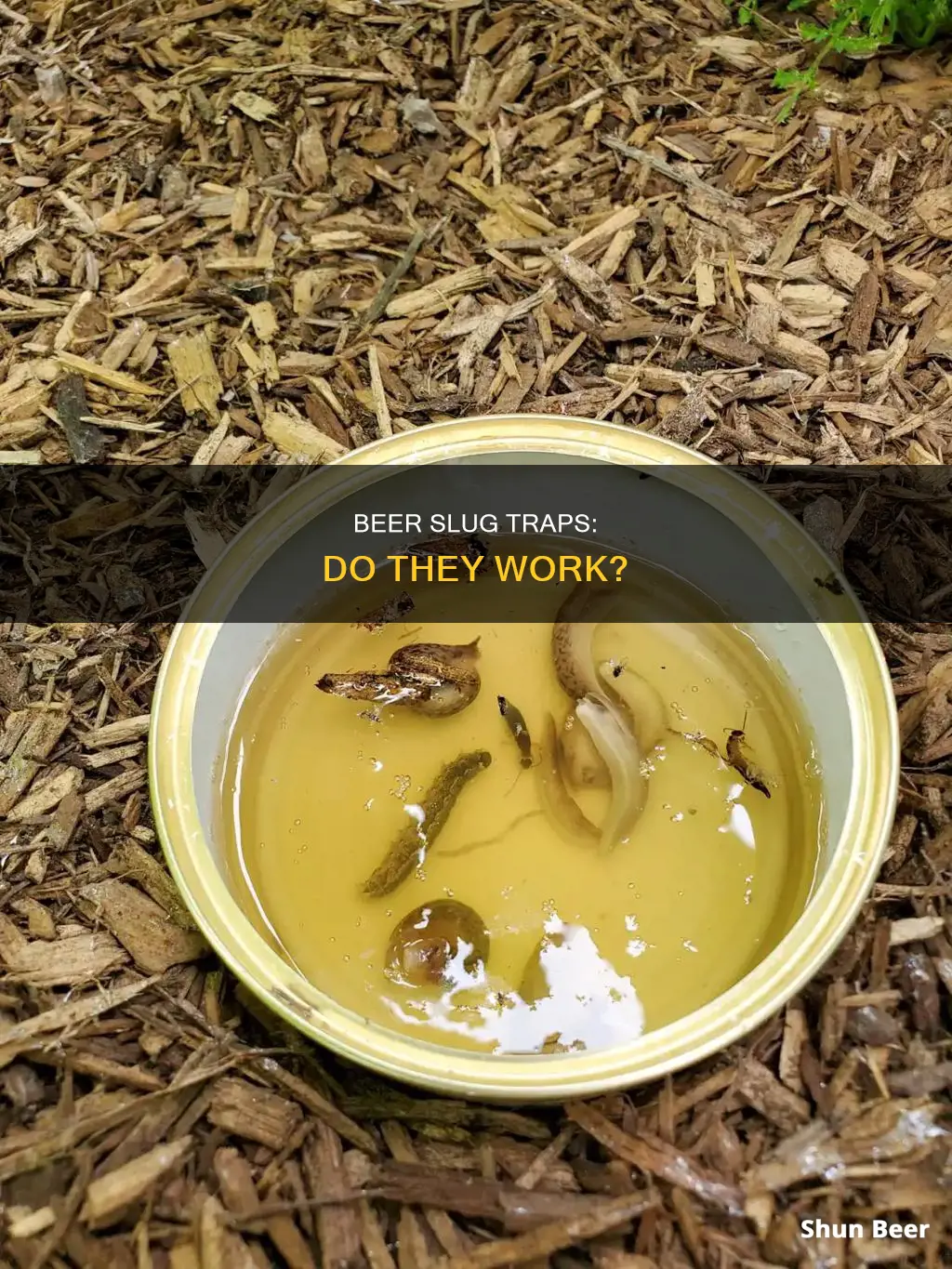
Beer slug traps are a popular method for deterring slugs from destroying plants. The idea is that slugs are attracted to the sweet, fermented yeasty aroma of beer. They then enter the trap, drink the beer, become intoxicated, and drown. However, the effectiveness of beer slug traps is debated. While some gardeners claim they work like magic, others argue that they are more myth than reality. So, do beer slug traps work?
| Characteristics | Values |
|---|---|
| Effectiveness | Beer slug traps are effective in attracting slugs, but not in killing them. |
| Distance | Beer slug traps only work over a very short distance. |
| Slug Behaviour | Most slugs will drink the beer and leave. A small minority will drown. |
| Slug Attraction | Slugs are attracted to the yeast and yeast by-products in beer. |
| Container Type | Any container with a wide opening can be used, e.g. cans, plastic cups, cut water bottles. |
| Container Placement | Containers should be partially buried with the rim level with the soil surface. |
| Beer Type | Light, yeasty beers like lagers are most effective, but any beer will work. |
| Alternative Methods | Watered-down sourdough starter is an effective alternative to beer. |
What You'll Learn

How to make a beer slug trap
Beer slug traps are an effective way to control slug populations in your garden. Slugs are attracted to beer due to its sweet, fermented, yeasty aroma. Here is a step-by-step guide on how to make a beer slug trap:
Choose a Container:
Select a container with a wide opening that can hold a couple of inches of beer. You can use a variety of upcycled containers such as cat food cans, tuna cans, plastic food storage containers, yogurt tubs, cut water bottles, or plastic cups. The container should be wide and shallow, but deep containers can also work.
Prepare the Container:
Partially bury the container in the ground so that the top rim is level with or just above the soil surface. This will make it easier for slugs to crawl or fall into the trap. If using a tall container with a curved rim, burying it slightly can help slugs enter the trap.
Add Beer to the Trap:
Fill the container about one-third to halfway with beer. Add at least one inch of beer, and up to 2-3 inches if your container is large. There is no need to fill the trap completely, as slugs should not be able to crawl back out. Any type of beer will work, but slugs seem to be especially drawn to light, yeasty beers like lagers, pilsners, hefeweizen, or blonde ales.
Place the Trap in the Garden:
Position the beer trap in an area with high slug activity, such as under slug-prone plants like lettuce or strawberries. Look for shiny slug trails and place the traps nearby. Beer traps typically only attract slugs within a few feet, so you may need to use multiple traps throughout your garden or a couple per garden bed.
Maintain the Trap:
Check the trap every couple of days and refresh the beer as needed. The beer may evaporate more quickly in hot conditions, so you may need to add more beer or refresh it more frequently. Also, the traps can get quite stinky after a few days, so rinsing the container before refilling it is recommended.
Dispose of the Slugs:
You can remove dead slugs from the trap and put them in the compost, or leave them in your garden for birds, snakes, toads, or other slug predators to eat.
While beer slug traps can be an effective method for controlling slug populations, it is important to note that they may not protect your plants from damage. The strong odour of malt in the beer can attract slugs from afar, increasing the slug population in your garden and potentially causing more damage to your plants. To mitigate this, place the traps as far as possible from the plants you want to protect.
Exploring Beer Enhancement With Bazooka Tubes
You may want to see also

Do beer slug traps attract other pests?
Beer slug traps are known to attract slugs and snails, but they can also attract other pests. The traps work by luring these pests with the smell of malt, yeast, or yeast by-products. While slugs and snails are the primary targets, other insects may also be drawn to the beer.
The odor of malt or yeast in the beer can attract slugs and snails from a distance, increasing the local population. This can result in more damage to nearby plants as the pests develop an increased appetite after consuming the beer. Therefore, it is important to place the traps away from plants that are vulnerable to slug and snail damage.
While beer slug traps are effective in luring and trapping slugs and snails, they may not be the best option for those concerned about attracting other pests. The traps can lure various insects, and even some mammals, that are attracted to the smell of malt or yeast.
To minimize the risk of attracting other pests, it is recommended to use a trap with a lid that has small holes for the slugs and snails to crawl through. This can help prevent larger pests from accessing the beer while still allowing the targeted pests to enter. Additionally, placing the traps in areas with high slug and snail activity but away from vulnerable plants can help ensure the traps are effective without causing unintended damage.
Overall, while beer slug traps can attract other pests, proper placement and use of the traps can help reduce the risk and minimize potential negative consequences.
Beer Enemas: Do They Work or Are They Dangerous?
You may want to see also

What kind of beer is best for slug traps?
Beer slug traps do work, but they are not a perfect solution. While they do attract slugs, most of the slugs that visit the trap will drink some beer and then continue on their way. Some will even climb out of the trap. Only a small minority of slugs will fall into the trap and drown.
The odour of malt in beer attracts slugs from far and wide, increasing the population of slugs nearby and causing more damage to your plants. Therefore, it is recommended that you place slug traps as far away as possible from the plants you want to protect.
When it comes to choosing the best beer for slug traps, any beer will do, even non-alcoholic beer. Slugs are attracted to the smell of malt and yeast, so it is the yeast or yeast by-products that are the key attractants. The alcohol content has been shown to have little bearing on effectiveness. However, it is recommended that you use inexpensive beer for slug traps. The cheapest types of lager are just as effective as more expensive brands, and bitter and lager catch similar numbers of slugs.
Beer Foam Stones: Do They Work?
You may want to see also

What kind of container is best for a beer slug trap?
When it comes to choosing a container for a beer slug trap, there are a few things to consider. Firstly, the container should be wide and shallow, with a wide opening, as this will make it easier for the slugs to crawl in. Secondly, the container should be able to hold at least an inch or two of beer, as this is the optimal depth for luring and trapping slugs. Thirdly, it is best to use a container that can be recycled or upcycled, such as a plastic food container or a cut-up plastic bottle, as this is both economical and environmentally friendly.
When setting up the trap, it is important to partially bury the container so that the rim is level with or just above the soil surface. This will ensure that the slugs can easily crawl into the trap. It is also important to place the traps in areas where slug activity is high, such as near seedlings or slug-prone plants like lettuce and strawberries. For effective coverage, place the traps about every eight to ten feet, or even closer if you are using smaller containers.
While the type of beer used is not as important as the container and placement of the trap, it is generally recommended to use cheaper, lighter, and more yeasty beers, such as lagers or pilsners. The sweet, fermented, yeasty aroma of the beer is what attracts the slugs, so choosing a beer with a strong scent will increase the trap's effectiveness.
It is worth noting that beer traps may not be the most effective method for controlling slug populations, as they can attract slugs from neighbouring areas and do not always result in the slugs' deaths. However, they can still be a useful tool when used in conjunction with other slug control methods, such as physical barriers or biological treatments.
Morning Beer: Should You Drink Before Work?
You may want to see also

How to dispose of slugs caught in a beer trap
Beer slug traps are an effective way to get rid of slugs in your garden. However, disposing of the slugs caught in these traps is another task altogether. Here are some ways to dispose of the slugs caught in a beer trap:
Composting
You can remove the dead slugs and snails and put them in the compost. Slugs will dry up and wither away quickly if tossed into the compost.
Leaving them for predators
If you don't want to compost the dead slugs, you can leave them in your yard or garden. Birds, snakes, toads, or other slug predators will feed on them.
Flushing them down the toilet
Another option is to simply flush the dead slugs down the toilet. This method ensures they are disposed of quickly and efficiently.
Burying them
You can also bury the dead slugs in a hole in your garden. This method returns the slugs to the soil and allows them to decompose naturally.
Using them as fertiliser
Additionally, you can use the dead slugs as fertiliser for your plants. While this may seem unpleasant, slugs can provide nutrients to your plants as they decompose.
It is important to dispose of the slugs humanely and in an environmentally friendly manner. These methods provide a way to do that while also ensuring your garden remains slug-free.
Beer Bar Memberships: Are They Worth the Cost?
You may want to see also
Frequently asked questions
Yes, beer slug traps do work, but they are not 100% effective. While they do attract slugs, most will simply drink the beer and then continue on their way. A small minority will fall into the trap and drown.
Beer traps work by attracting slugs with the sweet, fermented yeasty aroma of beer. As they enter the trap and drink the beer, they become intoxicated, fall into the liquid, and drown.
To make a beer slug trap, partially bury a small container, such as a tuna tin or plastic bottle, in the ground and fill it with beer. Place the traps in areas where slug problems are the greatest, and be sure to cover them so the beer doesn't get diluted by rain.







